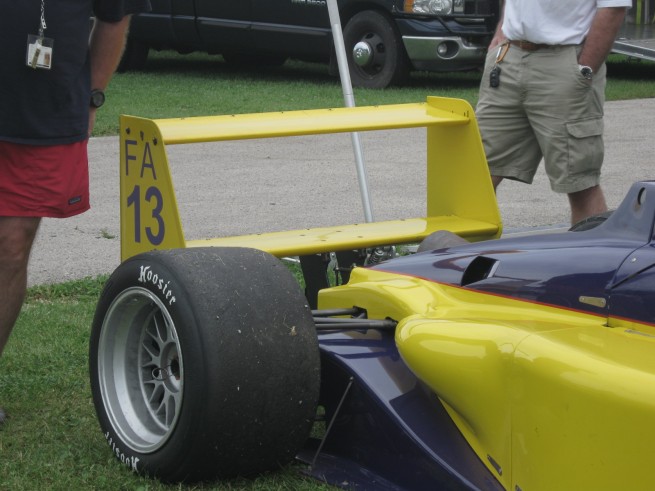Just like last year, I was fortunate enough to be able to attend the SCCA June Sprints at Road America this June. And just like last year, I was able to get up close and personal with some high-performance machinery in the infield paddock. For example, this guy — the #13 Swift 8 (credited to Bob Hogan in the event programme) competing in Formula Atlantic.
Formula Atlantic was originally a regional driver-development series somewhere between Formula 2 (which later became GP2, and has now become Formula 2 again) and Formula 3 in performance. Unlike most modern open-wheel development series (GP2, F2, IFM, WSbR, WTFBBQ, LMNOP, …) Formula Atlantic in its present incarnation is open to a wide range of cars under a fairly liberal set of regulations and includes classic Super Vee cars as well as Star Mazda chassis. This car is a Swift model 8, predecessor to the Swift 016 that runs as a (spec… sigh) chassis in the pro Formula Atlantic series. Spec series make Carroll Smith baby Jesus cry.
Among other things, FA quite obviously permits underbody tunnels rather than limiting the cars to a diffuser that starts aft of the rear axles, and this car takes quite obvious advantage. The unfaired (and decidedly unaerodynamic) gearbox and obtrusive pushrod, lower control arm, driveshaft, and tunnel stay make me wonder exactly how much air is coming out of these tunnels, and I can’t help but note that Intrepid built their works-frightening RM1 with tunnels that ran under the rear suspension partly to avoid this situation. The low gearbox and eminently sensible suspension geometry must surely contribute to mechanical grip, and at less-than-Grand Prix speeds maybe that’s a better tradeoff.
Speaking of Grand Prix speeds, it’s interesting to see the Swift’s exhaust running under the rear wing element and obviously feeding the underbody, much like current Formula One practice (from the teams that’re doing it right, at least). As a glib dilettante aero nerd, I can’t help but wonder what would happen if those tunnels were less obstructed and the lower plane of the rear wing had better airflow. I guess I’ll just have to make a small fortune, learn to drive a fast open-wheeler competitively, buy a Swift 008, and find out. Cheeky, aren’t I?
Here’s the front suspension and one of the tireless crew. When I approached these folks they were cheerful and pleased that I was interested in their car, but after I’d taken a few pointed photos of their aero setup and suspension geometry I started getting some skeptical looks, bordering on the unfriendly. I don’t doubt that another FA team could divine some setup information from these now-obsolete shots, but no worries guys — I may talk big on this blog, but I’m quite ignorant.
Anyway, note the lack of front-end aero bits (bargeboards and the like) as well as the eminently-sensible front suspension geometry. The front end actually has a single-keel layout, which I presume keeps the nose just high enough to feed the underbody reliably no matter what the front of the car’s doing without compromising roll centres the way a modern zero-keel F1 suspension would do. That’s what happens when your car is slow enough to make mechanical grip a significant factor. (“Slow”. Heh. These cars lap Road America right around two minutes flat. That ain’t slow!)
Looking back at the rear of the car, you can see that the underbody tunnels rise rather steeply through the rear suspension; that the lower wing element doesn’t seem to get much help in the way of airflow; and that holy shit those are big fucking tires. They are even more impressive in person. Those Hoosiers are big damn tires. Also, I’m guessing that the lower wing element mostly serves as an extension of the underbody rather than anything else: look at its inclination. Oddly, no flap on either plane.
Here’s a look at the front end aero bits. Not much to see here, but it gives us another shot at the front lower control arms (and their single-keel layout) and the, um, utilitarian front wing endplates. It’s easy for a Formula One nerd like me to forget that until 2009 there just wasn’t much going on at the front endplates; even the 2008 endplates were pretty pedestrian. I guess they matter more when they’re closer to the outside of the front tires and influence outboard airflow more dramatically.
Now here’s a more interesting shot of the front end. Notice the front wing mounts, which are somewhat less than fully faired-in, and the sawtooth vortex generator right behind them which no doubt cleans up the turbulent airflow coming therefrom (which heads right into the rod-end inboard connectors of the lower control arms… but let’s not quibble). The front wing mainplane is a single section all the way across, aided by bigass flaps away from the nose and presumably interacting with the bodywork closer in.
Here’s another shot from a bit closer to the ground. (Those are big damn slicks on the front, too!) This gives a bit more of a sense of the front suspension geometry (on the off-chance that you care anywhere near as much as I do) as well as the generally unimpeded airflow from the front of the car to the rear wing. Quite a difference from modern GP cars; where’s the engine air intake?
The FAs ran with the Formula Mazdas this year, same as last, and while the Atlantics were more impressively quick both classes could take Road America’s turn 7 at full throttle… and a pack of rotary-engine cars at full song is like unto a chorus of angels. Badass angels, with overdriven guitars. What a great way to spend a Sunday.








0 Responses to “Car porn: Swift 8 Formula Atlantic at Road America”